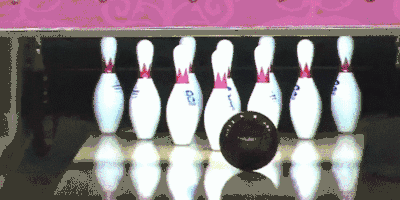Strike (bowling)
A strike is a term used in bowling to indicate that all of the pins have been knocked down with the first ball roll of a frame. On a bowling scoresheet, a strike is marked by an "X".[1]

In American nine-pin bowling, a ringer is an equivalent term for knocking all nine pins in the first ball of the frame (known as a full house).
Scoring

When all ten pins are knocked down with the first ball roll (called a strike and typically rendered as an "X" on a score sheet), a player is awarded ten points, plus a bonus of whatever is scored with the next two rolls (not necessarily the next two frames). In this way, the points scored for the two rolls after the strike, are counted twice.
- Frame 1, ball 1: 10 pins (strike)
- Frame 2, ball 1: 3 pins
- Frame 2, ball 2: 6 pins
- The total score from these throws is:
- Frame one: 10 + (3 + 6) = 19
- Frame two: 3 + 6 = 9
- TOTAL = 28
Strike scoring works similarly for five-pin bowling, except strikes are worth 15 points rather than 10 (as the pins are scored with the values of 2, 3, 5, 3, and 2).
Consecutive strikes
Two consecutive strikes are referred to as a "double" (or a "Barney Rubble" to rhyme). Three strikes bowled consecutively is known as a "turkey" (sometimes a "sizzling turkey" if on the first three frames). Any longer string of strikes is referred to by a number affixed to the word "bagger," as in "four-bagger" for four consecutive strikes. The word "hambone" is used to describe four consecutive strikes. Likely a name derived from bowling's early days where various food items were given out to winners of competitions as prizes.[5]
When a player is "on the strikes", a string is often referenced by affixing "in a row" to the number of strikes bowled consecutively. Six strikes in a row are sometimes referred to as a "six pack" or "sixer".[6] Six strikes and nine strikes in a row can also be referred to "wild turkeys" and "golden turkeys" respectively. Any string of strikes starting in the first frame or ending "off the sheet" (where all of a bowler's shots from a certain frame to the end of the game strike) are often referred to as the "front" or "back" strikes, respectively (e.g. the 'front nine' for strikes in frames 1-9, or the 'back six' for strikes in frames 7, 8, and 9 with a turkey in the tenth). Twelve strikes in a row is a perfect game; 36 consecutive strikes constitutes a 900 series. Due to the difficulty of achieving a game of 300 or a series of 900, many Bowling establishments have plaques engraved with 300 and 900 club members.
- A player who scores multiple strikes in succession would score like so:
- Frame 1, ball 1: 10 pins (strike)
- Frame 2, ball 1: 10 pins (strike)
- Frame 3, ball 1: 4 pins
- Frame 3, ball 2: 2 pins
- The score from these throws is:
- Frame one: 10 + (10 + 4)= 24
- Frame two: 10 + (4 + 2) = 16
- Frame three: 4 + 2 = 6
- TOTAL = 46
- The most points that can be scored in a single frame is 30 points (10 for the original strike, plus strikes in the two subsequent frames)
- The most points that can be scored in a single game is 300 points which is a perfect game.
- A player who bowls a strike in the tenth (final) frame is awarded two extra balls so as to allow the awarding of bonus points. If both these balls also result in ten pins knocked down each, a total of 30 points (10 + 10 + 10) is awarded for the frame. These bonus points do not count on their own, however. They only count as the bonus for the strike.
Publications
- Benner, Donald; Mours, Nicole; Ridenour, Paul; USBC, Equipment Specifications and Certifications Division (2009). "Pin Carry Study: Bowl Expo 2009" (Slide show presentation). bowl.com. Archived (PDF) from the original on December 7, 2010.CS1 maint: ref=harv (link)
- Freeman, James; Hatfield, Ron (July 15, 2018). Bowling Beyond the Basics: What's Really Happening on the Lanes, and What You Can Do about It. BowlSmart. ISBN 978-1 73 241000 8.CS1 maint: ref=harv (link)
References
- Bowling-Tips.org (2013). "How to Bowl a Strike". Bowling-Tips.org. Retrieved 2014-04-01.
- Benner, Mours & Ridenour 2009.
- Freeman & Hatfield 2018, Chapter 8 ("Why Does My Ball Hook?").
- Freeman & Hatfield 2018, Chapter 10 ("The Pocket Isn't the Pocket... and It's Nowhere Near Where You Think It Is").
- Jeff Goodger (2013). "Strings of Strikes". About.com. Retrieved 2014-04-01.
- PBA (2012). "Professional Bowlers Association: Bowling Lingo". Professional Bowlers Association. Retrieved 2012-12-01.

